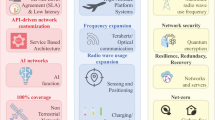Abstract
Nowadays, the infrastructure for major broadband networking in cellular communication introduces 6G-Network in a box (6th Generation-NIB) mobile phone networks. As surveyed, the functional execution of 6G-NIB networks addresses several unresolved problems, like assigning power to all points, power management, and efficient distribution. Hence, these unresolved issues have been taken into consideration and resolved through an optimized power allocation and distribution system using the Quasi-Convex Problem-Solving approach of Serial Polynomial Programming (SPP). It helps to boost the energy level of all the points among the peer to peer network and spectral performance of 6G-NIB has been substantially improved without compromising the network Quality of Service (QoS). In considering the transmission power, QoS, and sequential interference elimination (SIE) constraints, To test the proposed power allocation structure and to demonstrate improved efficiency against the traditional method, the simulation environment has been analyzed using Monte Carlo Simulation. The outcomes indicate that the proposed SPP-based power optimization principle greatly enhances 6G -NIB enabled Internet of Things (IoT) network efficiency and performance effectively.













Similar content being viewed by others
References
Nguyen, D. C., Cheng, P., Ding, M., Lopez-Perez, D., Pathirana, P. N., Li, J., … Poor, H. V. (2020). Wireless AI: Enabling an AI-Governed Data Life Cycle. arXiv preprint arXiv:2003.00866
Hui H, Ding Y, Shi Q, Li F, Song Y, Yan J (2020) 5G network-based internet of things for demand response in smart grid: a survey on application potential. Appl Energy 257:113972
Baskar S, Dhulipala VS (2018) Collaboration of trusted node and QoS based energy multi path routing protocol for vehicular ad hoc networks. Wirel Pers Commun 103(4):2833–2842
Panda S (2020) Joint user patterning and power control optimization of MIMO–NOMA systems. Wirel Pers Commun:1–17
Mobini Z (2020). Secrecy performance of non-orthogonal multiple access cognitive untrusted relaying with friendly jamming. AEU-Int J Electron Commun 153156
Cherifi A, Mrabet H, Bouazza BS, Aljunid SA (2020) Performance enhancement of multiple access 3D-OCDMA networks using a pascal triangle codes. Opt Quant Electron 52(2):1–16
Yu Y (2020). An overview of the wireless key technologies of 5G. In IOP conference series: materials science and engineering (Vol. 719, no. 1, p. 012046). IOP publishing
Gui G, Liu M, Tang F, Kato N, Adachi F (2020) 6G: opening new horizons for integration of comfort, security and intelligence. IEEE Wirel Commun:1–7
Khan WU, Jameel F, Jamshed MA, Pervaiz H, Khan S, Liu J (2020). Efficient power allocation for NOMA-enabled IoT networks in 6G era. Phys Commun 101043
Asghar M, Yaqoob M, Siddiqui MA, Munawar N, Waseem A, Nabi A (2020) Flow-injection determination of manganese (II) using surfactant enhanced diperiodatonickelate (IV)-rhodamine 6G chemiluminescence. Luminescence 35(1):79–89
Li X, Ni R, Chen J, Lyu Y, Rong Z, Du R (2020) End-to-end network slicing in radio access network, transport network and Core network domains. IEEE Access 8:29525–29537
Abdel-Mohsen HT, Abood A, Flanagan KJ, Meindl A, Senge MO, El Diwani HI (2020) Synthesis, crystal structure, and ADME prediction studies of novel imidazopyrimidines as antibacterial and cytotoxic agents. Arch Pharm 353(3):1900271
Baskar S, Periyanayagi S, Shakeel PM, Dhulipala VS (2019) An energy persistent range-dependent regulated transmission communication model for vehicular network applications. Comput Netw. https://doi.org/10.1016/j.comnet.2019.01.027
Saad, W., Bennis, M., & Chen, M. (2019). A vision of 6G wireless systems: applications, trends, technologies, and open research problems. IEEE Netw
Baskar S, Shakeel PM, Kumar R, Burhanuddin MA, Sampath R (2020) A dynamic and interoperable communication framework for controlling the operations of wearable sensors in smart healthcare applications. Comput Commun 149:17–26
Yaacoub E, Alouini MS (2019). A key 6G challenge and opportunity--connecting the remaining 4 billions: a survey on rural connectivity. arXiv preprint arXiv:1906.11541
Guo W (2019). Explainable artificial intelligence (XAI) for 6G: improving trust between human and machine. arXiv preprint arXiv:1911.04542
Thakur P, Kumar A, Pandit S, Singh G, Satashia SN (2019) Frameworks of non-orthogonal multiple access techniques in cognitive radio communication systems. Chin Commun 16(6):129–149
Long Q, Chen Y, Zhang H, Lei X (2019). Software defined 5G and 6G networks: a survey. Mobile networks and applications, 1-21
Muruganathan S, Faxer S, Jarmyr S, Gao S, Frenne M (2019). On the system-level performance of coordinated multi-point transmission schemes in 5G NR deployment scenarios. In 2019 IEEE 90th vehicular technology conference (VTC2019-fall) (pp. 1-5). IEEE
Wang Y, Chen W (2020). An AoI-optimal scheduling method for wireless transmissions with Truncated Channel inversion. arXiv preprint arXiv:2001.01234
Ibrahim A, Ngatched TM, Dobre OA (2019) Using Bender’s decomposition for optimal power control and routing in multihop d2d cellular systems. IEEE Trans Wirel Commun 18(11):5050–5064
Author information
Authors and Affiliations
Corresponding author
Additional information
Publisher’s note
Springer Nature remains neutral with regard to jurisdictional claims in published maps and institutional affiliations.
This article is part of the Topical Collection: Special Issue on Network In Box, Architecture, Networking and Applications
Guest Editor: Ching-Hsien Hsu
Rights and permissions
About this article
Cite this article
Gnanavel, V.K., Srinivasan, A. Effective power allocation and distribution for 6 g – network in a box enabled peer to peer wireless communication networks. Peer-to-Peer Netw. Appl. 14, 2351–2360 (2021). https://doi.org/10.1007/s12083-020-00942-1
Received:
Accepted:
Published:
Issue Date:
DOI: https://doi.org/10.1007/s12083-020-00942-1




